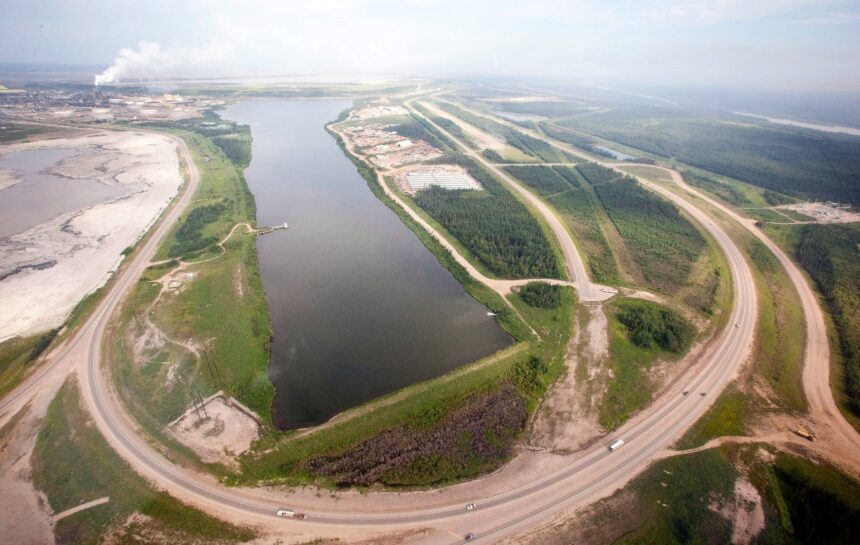The skies over northern Alberta look different when you drive north of Fort McMurray. The clouds here seem to hang lower, carrying the weight of decades of industrial development. I’ve been making this journey for nearly eight years now, documenting the evolving story of Canada’s oil sands—but this time feels different.
Standing at the edge of a massive tailings pond on a crisp May morning, I watch as environmental engineer Sophia Chen points toward a series of pipes leading from the dark, oily water to a facility in the distance.
“This is where it all starts,” she explains, adjusting her hard hat. “What most people don’t realize is that for every barrel of oil produced, about three barrels of water become tailings waste.“
These tailings—a toxic mixture of water, clay, unrecovered hydrocarbons, and dissolved chemicals—have accumulated in massive quantities across northern Alberta. Current estimates suggest more than 1.4 trillion liters are stored in these human-made ponds, covering an area larger than the city of Vancouver.
Now, industry and government are seriously considering a controversial solution: injecting this wastewater deep underground.
“We’re looking at what we call deep well disposal,” explains James Morrison, senior environmental policy advisor with Alberta Environment. “The proposal would see treated tailings water injected into porous rock formations more than a kilometer below the surface.”
The concept isn’t entirely new. The oil and gas industry has used similar techniques for decades to dispose of production water. But the scale and composition of oil sands tailings present unique challenges and concerns.
For the companies operating in the region, underground injection represents a potential path forward for an industry facing mounting pressure to address its environmental footprint. Imperial Oil and Canadian Natural Resources Limited have already begun pilot projects, with early results suggesting the approach could be technically feasible.
But deep well injection comes with serious questions—both technical and ethical—about potential groundwater contamination, long-term monitoring requirements, and whether we’re simply pushing today’s problem into tomorrow’s earth.
“We’re very concerned about what happens to that water once it goes down there,” says Melina Williams, environmental coordinator with the Athabasca Chipewyan First Nation. I met Williams at her office in Fort Chipewyan, where she spread maps across her desk showing the proximity of proposed injection sites to traditional territories.
“Our people have lived with the downstream impacts of oil sands development for generations,” she tells me, tracing her finger along the blue line of the Athabasca River. “The water, the fish, the animals—they’re all connected. Once that water goes underground, we lose our ability to monitor what happens to it.“
Scientists studying the proposal raise similar concerns. Dr. Alec Thompson, hydrogeologist at the University of Alberta, has spent the past decade studying underground water movements in the region.
“The formations they’re targeting are deep and separated from drinking water aquifers by thick layers of impermeable rock,” he acknowledges. “But our understanding of fluid migration over very long time periods—we’re talking hundreds or thousands of years—is still limited.”
The science behind the proposal is complex. Industry plans call for tailings to undergo treatment processes to remove solids and some contaminants before injection. The target formations—typically saline aquifers or depleted oil reservoirs—are naturally separated from freshwater sources by geological barriers.
Environment Canada reports indicate that properly designed injection wells have a strong safety record. However, a 2023 study published in the Canadian Journal of Earth Sciences documented cases where fluids migrated beyond their intended zones through previously undetected fractures or abandoned wellbores.
The economics are equally complicated. Building the necessary infrastructure for large-scale deep well injection would cost billions—but continuing to maintain growing tailings ponds isn’t cheap either. A 2024 report from the Pembina Institute estimates the current environmental liability of oil sands tailings at over $130 billion.
“The question isn’t just whether we can do this safely,” says economist Maria Rodriguez with the Canadian Climate Institute. “It’s whether we should be investing in end-of-pipe solutions versus accelerating the transition away from fossil fuels altogether.”
For communities that have lived with tailings ponds for decades, however, the idea of removing these massive water bodies from the landscape holds undeniable appeal.
Gerald Martin, a 67-year-old elder from Fort McKay First Nation, remembers hunting and trapping across this landscape as a young man. We walk together along a reclaimed section of forest that was once part of a mining operation.
“When I was young, you could drink from any stream,” he says, pausing to examine a young spruce tree. “I won’t see that again in my lifetime. But maybe my grandchildren could, if they find a way to clean all this up.“
The Alberta Energy Regulator is currently reviewing applications for expanded deep well injection pilots, with public consultations expected later this year. Meanwhile, a coalition of environmental organizations and Indigenous communities is calling for more rigorous study before any large-scale implementation.
Back at the tailings pond, I watch a flock of birds circle overhead, carefully steered away by noise cannons designed to prevent landings on the toxic water. The irony isn’t lost on me—we’ve created a problem so vast that our only solution may be to hide it underground.
As I prepare to leave, Chen, the environmental engineer, offers a final thought. “There are no perfect solutions here,” she says, looking out over the dark water. “But doing nothing isn’t an option either. These tailings aren’t going away on their own.”
In the balance hang competing visions of Alberta’s future—one where the legacy of oil sands development is gradually buried beneath the surface, and another where we face the full complexity of the waste we’ve created and find more sustainable paths forward.
The province now stands at a crossroads, deciding not just where this toxic water will go, but what kind of relationship we want with the land and water that sustains us all.






